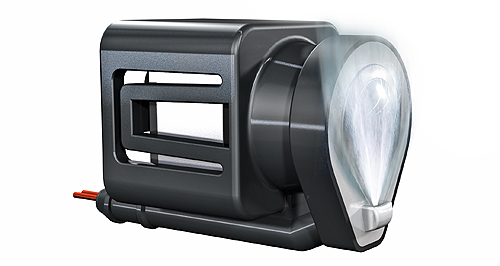Make / Model Search
News - ContinentalContinental comes clean on car sensorsClear eye: A small blast of water followed by another of air is Continental’s solution to keeping autonomous vehicle sensors clean. Dirty sensors that can send autonomous vehicles blind get Continental clean-up4 Jul 2017 By IAN PORTER in HANOVER GERMAN automotive parts supplier Continental has developed cleaning systems for on-board sensors such as video cameras, radars and lidars to keep the autonomous vehicles of the future running reliably and safely. It also has come up with a way of immersing electric vehicle batteries in oil to ensure stable temperatures for maximum efficiency. According to Continental, dirty sensors on automated cars have the potential to trigger limp-home mode or even bring the vehicle to a halt. “If the sensor says ‘I cannot work’, the car stops,” said Continental engineer Rolf-Dieter Schlein. “That’s impossible, totally.” Speaking at the recent Continental TechShow, Mr Schlein said car-makers were already getting feedback that the rear cameras on cars could become inoperative because they were “totally blind”. He said dirt accumulation and frost after an icy night were the main culprits. Continental has been designing cleaning systems for windscreens, taillights and headlamps for 30 years, and Mr Schlein said the company brought this experience to bear on the new problem of sensor cleaning. “Now we have the complete system,” he said. “We have the reservoir, we have the pumps, we have the hoses, all heated if necessary for wintertime, and we can heat not only the hoses and the fluids, we can also heat the lenses.” Mr Schlein said dirty cameras were a risk when driving, adding that only technologies that run reliably can make a contribution to road safety. The cleaning system would be automatic, he said.  Left: Continental engineer Rolf-Dieter Schlein Left: Continental engineer Rolf-Dieter Schlein“The camera can recognise if she’s blind. There is an algorithm behind the camera, and the camera normally expects changing images,” he said. “If there is an amount of pixels which didn’t change any more, even if you are driving, then she says ‘there must be something wrong, I must be cleaned’.” That triggers a pump and some electro-hydraulic valves to clean the affected sensor. Mr Schlein said that while current vehicles may have between five and 10 sensors, future cars would need many more. “If we are talking about electric and automated driving, we expect about 20 sensors per car,” he said. “That’s a lot.” He said the cleaning system would likely be broken into smaller parts rather than running tubes all over the car. “We will not have one reservoir. We will have four, and then we have not concentrated this weight at one point. Weight is also an every-time question. “So we are using, in the first step, a dosing valve. That means it doesn’t matter how long the pump runs, it gives only a short shot of water, so we can control the amount of water per cleaning cycle. That will help keep the water consumption on a very low level.” Continental has already worked out a way to improve the performance of the cleaners. “The second step is we are trying a combination of water and air. That means first water, and then an air shot to clean the last droplets. “This is important for active sensors like lidar and radar. They have the problem they are an active sensor. That means they sense some waves, radar waves or (laser) light waves, and the rates for the feedback from the outside determine how the sensor reacts.” Continental has also developed new hoses and pipes to improve the cooling systems on electric vehicles and has come up with a radical plan to immerse the batteries in oil as part of the thermal management of the batteries. Electric vehicle batteries need stable temperatures to work at their most efficient, so Continental has developed new hoses and pipes that improve battery temperature control and battery life while reducing the weight of the cooling system. The company already provides cooling lines up to four metres long for hybrid and electric vehicles – one for batteries and one for the motor and the electronics. These circuits use water as a coolant and sometimes oil, but Continental has come up with a way to augment these systems during high thermal loads. It has linked the cooling system into the cabin air-conditioning circuit so that it assist the other two circuits. The new hoses and pipes for EV cooling are 25 per cent lighter than those in use, now thanks to a new mixture of rubber, polyamide and aluminium. The new designs allow the company to use smaller cross sections in the pipes and hoses, reducing the amount of coolant needed while improving the pipe system’s ability to deal with under- and over-pressure by 50 per cent. The new oil hose lines for cooling the battery mean that car-makers can now immerse the batteries in oil to improve temperature stability. Oil does not carry an electrical charge so there could not be any short-circuits that could cause the total failure of the battery. Continental believes the improved control of the battery temperature will lead to improved battery efficiency and, therefore, better range and durability.  Read more27th of June 2017  Continental’s mild-hybrid tech cuts CO2 emissionsDiesel more viable with Continental's new catalytic converter and mild-hybrid system22nd of June 2017  New approach to in-car audio from ContinentalContinental replaces speakers with acoustic panels to reduce weight, improve audio |
Click to shareContinental articlesMotor industry news |











Facebook Twitter Instagram